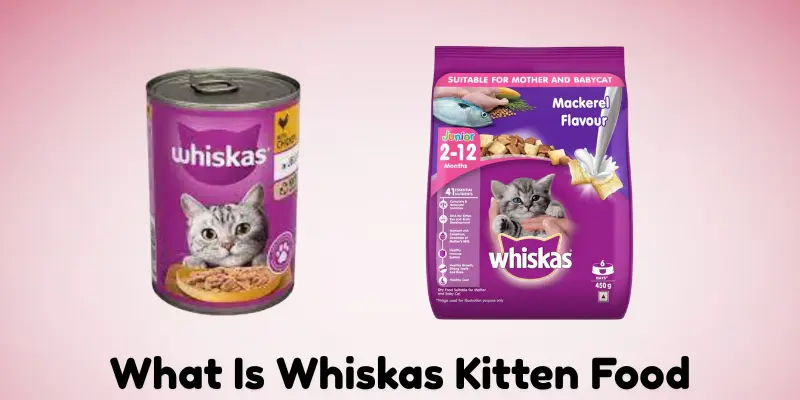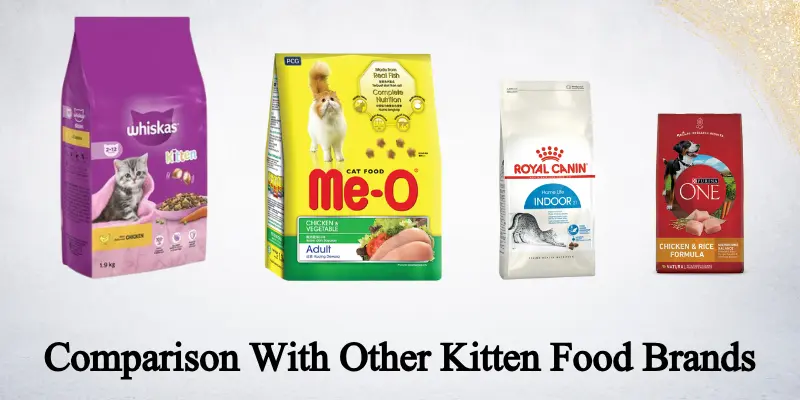Whiskas Kitten Food – Nutrition, Types And Feedings
Published: 23 May 2025
Whiskas kitten food is a specially made meal for little kittens who are growing fast and need the right nutrition. It is soft, tasty, and full of important things like protein, vitamins, and minerals that help your kitten grow strong and healthy. Whether your kitten is learning to chew or play, Whiskas gives the energy and care they need every day.
Table of Contents
What Is Whiskas Kitten Food?

Whiskas Kitten Food is a special food made just for kittens aged 2 to 12 months. It is designed to give them everything they need to grow like protein for muscles, calcium for bones, and vitamins for good health. It comes in tasty flavours and soft textures that are easy for little kittens to chew and enjoy.
What Makes Whiskas Kitten Food Special?
Whiskas Kitten Food is special because it is made with real ingredients like chicken, milk, and fish that kittens love. It gives the right balance of nutrition for healthy growth, strong bones, and bright eyes. Its soft texture and yummy taste make it easy and fun for kittens to eat every day.
Types of Whiskas Kitten Food Available
Whiskas offers different types of kitten food to match your kitten’s age, taste, and needs. Here are the main types:
1. Whiskas Dry Kitten Food (Kibble)
Crunchy small pieces that help clean teeth and are full of nutrients.
2. Whiskas Wet Kitten Food (Pouches or Cans)
Soft and juicy meals with real meat or fish, easy to chew and digest.
3. Flavours Available
Chicken, Tuna, Ocean Fish, and Milk to keep mealtime exciting for your kitten.
4. Age Suitability
Made especially for kittens from 2 to 12 months of age.
5. Pack Sizes
Comes in small and big packs, so you can choose what fits your budget and kitten’s appetite.
How To Feed Whiskas Kitten Food
Feeding your kitten the right way helps them grow strong and healthy. Here’s how you can feed Whiskas Kitten Food to your little one:
1. Feeding Amount
Feed your kitten the right amount based on their age and weight. Generally, kittens need 3-4 small meals a day.
2. Mixing Wet and Dry Food
You can feed your kitten a mix of dry food (kibble) and wet food (pouches or cans) for variety and extra nutrients.
3. Fresh Water
Always keep fresh water available for your kitten. This helps keep them hydrated, especially if they’re eating dry food.
4. Transitioning from Mothers Milk
If you’re switching from milk to solid food, start by mixing small amounts of Whiskas with their milk, gradually increasing the food portion.
5. Clean Feeding Bowls
Make sure to clean your kitten’s food and water bowls daily to avoid bacteria build up.
Comparison With Other Kitten Food Brands
Whiskas Kitten Food stands out among many kitten food brands. Here’s how it compares to other popular brands:

1. Whiskas vs Me-O
- Whiskas: Offers a wider range of flavours like chicken, tuna, and milk. It’s made with real meat and specially designed for kitten growth.
- Me-O: Known for being affordable but may have fewer flavor options and slightly less nutritional value for growing kittens.
2. Whiskas vs Royal Canin
- Whiskas: Budget-friendly with good nutritional balance, and a mix of wet and dry options.
- Royal Canin: A premium option with highly specific formulas for different kitten breeds, but it can be more expensive.
3. Whiskas vs Purina
- Whiskas: Offers a variety of textures and flavours, suitable for all kitten types.
- Purina: Also a trusted brand but is often considered pricier for the same quality of ingredients.
4. Price Comparison
- Whiskas: Affordable and offers good value for money, especially in larger packs.
- Other Brands: Can be higher priced, often with less variety or added benefits for kittens.
Advantages And Disadvantages Of Whiskas Kitten Food
Whiskas Kitten Food offers many benefits like balanced nutrition and variety, but it may not suit all kittens. Let’s explore its pros and cons.
| Pros |
|---|
|
| Cons |
|---|
|
FAQs About Whiskas Kitten Food
Got questions about Whiskas Kitten Food? Check out these frequently asked questions to learn everything you need to know about feeding your kitten.
Yes, you can mix Whiskas with homemade food, but ensure that the portion of Whiskas provides all the necessary nutrients your kitten needs. Always consult your vet for the best diet plan.
Kittens can start eating Whiskas Kitten Food at around 2 months of age, when they are ready to transition from their mother’s milk to solid food.
The amount depends on your kitten’s age and weight. Generally, kittens need 3–4 meals a day. Follow the feeding guidelines on the packaging or consult your vet for a tailored feeding plan.
Whiskas is generally easy to digest for most kittens, but if your kitten has a sensitive stomach, you should consider a special diet and consult a vet to see if Whiskas is suitable.
While dry food is great for kittens, it’s recommended to offer a mix of wet and dry food to ensure proper hydration and provide different textures and flavours.
Yes, the crunchy texture of Whiskas dry food helps to clean your kitten’s teeth, promoting good oral health as they grow.
You can feed your kitten Whiskas Kitten Food until they reach 12 months of age. After that, you should switch to adult cat food to meet their nutritional needs.
Whiskas does contain some preservatives to maintain freshness, but it uses safe, quality ingredients. You can check the ingredient list on the packaging for specific details.
Conclusions
Whiskas kitten food is an excellent choice for growing kittens, offering balanced nutrition, a variety of tasty flavours, and affordability. Its specially crafted formula helps support your kittens growth, energy, and health. While it may not be the best for all kittens, especially those with specific dietary needs, it’s a reliable and convenient option for most pet owners looking to keep their kittens happy and healthy.

- Be Respectful
- Stay Relevant
- Stay Positive
- True Feedback
- Encourage Discussion
- Avoid Spamming
- No Fake News
- Don't Copy-Paste
- No Personal Attacks

- Be Respectful
- Stay Relevant
- Stay Positive
- True Feedback
- Encourage Discussion
- Avoid Spamming
- No Fake News
- Don't Copy-Paste
- No Personal Attacks





